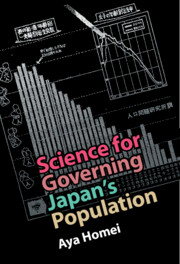Refine search
Actions for selected content:
13588 results in History of science and technology
Figures
-
- Book:
- Science for Governing Japan's Population
- Published online:
- 10 November 2022
- Print publication:
- 17 November 2022, pp viii-viii
-
- Chapter
-
- You have access
- Open access
- HTML
- Export citation
3 - Policy Experts
-
- Book:
- Science for Governing Japan's Population
- Published online:
- 10 November 2022
- Print publication:
- 17 November 2022, pp 92-121
-
- Chapter
-
- You have access
- Open access
- HTML
- Export citation
1 - Population Statistics
-
- Book:
- Science for Governing Japan's Population
- Published online:
- 10 November 2022
- Print publication:
- 17 November 2022, pp 25-57
-
- Chapter
-
- You have access
- Open access
- HTML
- Export citation
5 - Birth Control Survey
-
- Book:
- Science for Governing Japan's Population
- Published online:
- 10 November 2022
- Print publication:
- 17 November 2022, pp 173-197
-
- Chapter
-
- You have access
- Open access
- HTML
- Export citation
Abbreviations
-
- Book:
- Science for Governing Japan's Population
- Published online:
- 10 November 2022
- Print publication:
- 17 November 2022, pp xii-xiv
-
- Chapter
-
- You have access
- Open access
- HTML
- Export citation
Index
-
- Book:
- Science for Governing Japan's Population
- Published online:
- 10 November 2022
- Print publication:
- 17 November 2022, pp 288-298
-
- Chapter
-
- You have access
- Open access
- HTML
- Export citation
6 - Public Health Demography
-
- Book:
- Science for Governing Japan's Population
- Published online:
- 10 November 2022
- Print publication:
- 17 November 2022, pp 198-246
-
- Chapter
-
- You have access
- Open access
- HTML
- Export citation
Introduction
-
- Book:
- Science for Governing Japan's Population
- Published online:
- 10 November 2022
- Print publication:
- 17 November 2022, pp 1-24
-
- Chapter
-
- You have access
- Open access
- HTML
- Export citation
Dedication
-
- Book:
- Science for Governing Japan's Population
- Published online:
- 10 November 2022
- Print publication:
- 17 November 2022, pp v-vi
-
- Chapter
-
- You have access
- Open access
- HTML
- Export citation
Note on the Text
-
- Book:
- Science for Governing Japan's Population
- Published online:
- 10 November 2022
- Print publication:
- 17 November 2022, pp xi-xi
-
- Chapter
-
- You have access
- Open access
- HTML
- Export citation
Copyright page
-
- Book:
- Science for Governing Japan's Population
- Published online:
- 10 November 2022
- Print publication:
- 17 November 2022, pp iv-iv
-
- Chapter
-
- You have access
- Open access
- HTML
- Export citation
4 - National Land Planning
-
- Book:
- Science for Governing Japan's Population
- Published online:
- 10 November 2022
- Print publication:
- 17 November 2022, pp 122-172
-
- Chapter
-
- You have access
- Open access
- HTML
- Export citation
Conclusion
-
- Book:
- Science for Governing Japan's Population
- Published online:
- 10 November 2022
- Print publication:
- 17 November 2022, pp 247-262
-
- Chapter
-
- You have access
- Open access
- HTML
- Export citation
Select Bibliography
-
- Book:
- Science for Governing Japan's Population
- Published online:
- 10 November 2022
- Print publication:
- 17 November 2022, pp 263-287
-
- Chapter
-
- You have access
- Open access
- HTML
- Export citation
2 - Medical Midwifery and Vital Statistics
-
- Book:
- Science for Governing Japan's Population
- Published online:
- 10 November 2022
- Print publication:
- 17 November 2022, pp 58-91
-
- Chapter
-
- You have access
- Open access
- HTML
- Export citation
Innovations from the Levant: smallpox inoculation and perceptions of scientific medicine
-
- Journal:
- The British Journal for the History of Science / Volume 55 / Issue 4 / December 2022
- Published online by Cambridge University Press:
- 11 November 2022, pp. 423-444
- Print publication:
- December 2022
-
- Article
-
- You have access
- Open access
- HTML
- Export citation

Science for Governing Japan's Population
-
- Published online:
- 10 November 2022
- Print publication:
- 17 November 2022
-
- Book
-
- You have access
- Open access
- Export citation
Islamic philosophy and the globalization of science: Ahmed Cevdet's translation of the sixth chapter of Ibn Khaldun's Muqaddimah
-
- Journal:
- The British Journal for the History of Science / Volume 55 / Issue 4 / December 2022
- Published online by Cambridge University Press:
- 31 October 2022, pp. 459-475
- Print publication:
- December 2022
-
- Article
- Export citation
Allan Esterson and David C. Cassidy, Einstein's Wife: The Real Story of Mileva Einstein-Marić Cambridge, MA: MIT Press, 2019. Pp. 336. ISBN: 978-0-2625-3897-8. $19.95 (paperback). ISBN: 978-0-2620-3961-1. $29.95 (hardback).
-
- Journal:
- The British Journal for the History of Science / Volume 55 / Issue 4 / December 2022
- Published online by Cambridge University Press:
- 28 October 2022, pp. 531-533
- Print publication:
- December 2022
-
- Article
- Export citation
11 - Process Tracing and Narrative Science
- from IV - Interlude
-
-
- Book:
- Narrative Science
- Published online:
- 16 September 2022
- Print publication:
- 06 October 2022, pp 229-244
-
- Chapter
-
- You have access
- Open access
- HTML
- Export citation
